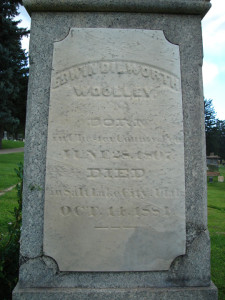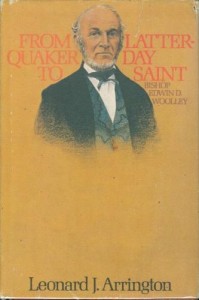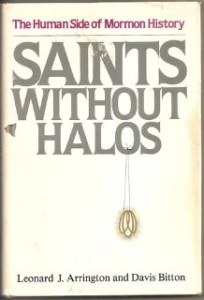When once described as outspoken, Dorothy Parker quipped: “Outspoken … by whom?” When historians suggest that Edwin Woolley was an outspoken Mormon bishop, I have the same reply. If you don’t know about this interesting favorite Mormon of ours, it’s my pleasure to introduce him to you.
 An early pioneer convert to the LDS Church, Edwin became a prominent businessman in Illinois. Born a Quaker, Woolley apparently used “thee” and “thou” frequently in his day-to-day speech, making him, I suspect, a go-to-guy for giving rhetorically-correct prayers, although the following early prayer of his suggests that he did not start off this way, and that his Quaker penchant for silence was his preferred mode of discourse. Shortly after baptism, he reportedly prayed with his family, saying, “Our Father in Heaven …” but stopped. Turning to his wife, Edwin asked, “What shall I say next? Thou hast been in the Church longer than I have.”
An early pioneer convert to the LDS Church, Edwin became a prominent businessman in Illinois. Born a Quaker, Woolley apparently used “thee” and “thou” frequently in his day-to-day speech, making him, I suspect, a go-to-guy for giving rhetorically-correct prayers, although the following early prayer of his suggests that he did not start off this way, and that his Quaker penchant for silence was his preferred mode of discourse. Shortly after baptism, he reportedly prayed with his family, saying, “Our Father in Heaven …” but stopped. Turning to his wife, Edwin asked, “What shall I say next? Thou hast been in the Church longer than I have.”
One day Joseph Smith walked into Edwin’s Nauvoo general store and, after looking around, said, “Brother Woolley, we want all your goods for the building up of the Kingdom of God.” After the Prophet left, Woolley dutifully boxed up his merchandise per President Smith’s request. When Brother Joseph returned, Edwin asked where he should deliver the items. The Prophet, obviously touched by Woolley’s loyalty, told him to restock his shelves, that Edwin had passed Joseph’s test. While I have heartburn reading about such a test of loyalty-although it pales in comparison to similarly heinous tests involving proposed polyandrous relationships-I respect Brother Woolley as a man of keen understanding, someone who knew what he was getting into, who knew Brother Joseph well and who, I believe, gladly complied.
Just to give you an idea how close Edwin was to Joseph and Hyrum, before leaving for Carthage Jail in 1844, Joseph Smith stopped by the Woolley home where, according to Brother Edwin, the Prophet uttered his famous phrase: “I am going like a lamb to the slaughter; but I am as calm as a summer’s morning.”
Suffering loss and hardship on the Mormon Trail, including a brutal stay at Winter Quarters, Edwin made it to Utah and built a house at the corner of what is now Third East and Third South streets, an adobe structure so tiny that part of his family was forced to live in the covered wagon beds just outside the front door. Brother Woolley eventually ran his own business, as well as Brigham Young’s personal business affairs, for many years, incorporating the Zion’s Cooperative Mercantile Institution (forerunner to ZCMI), among other operations. Later, he also served in the Utah House of Representatives.
In 1854 Edwin was called to serve as bishop of the lucky 13th Ward; lucky, that is, to have Edwin as bishop. A bishop’s duties during this period of Mormon history were more akin to that of a mayor, rather than a part-time church leader. His responsibilities included: protecting gardens and orchards from roaming livestock; building and staffing the ward school; supervising ward cultural activities (read: all cultural activities); supervising and staffing public works assignments; overseeing agricultural activities in his ward; and making sure that members of his congregation behaved themselves like good Mormons. Contrary to what we might think sometimes today, Brigham Young’s bishops were not mere “yes men.” When they disagreed with Brother Brigham, which was not infrequent, they were not removed from office, but respected for exercising independent judgment and … inspiration. Bishop Woolley, it should be noted, magnified his calling in this regard. PLEASE NOTE: Edwin Woolley was 13th Ward Bishop … for 27 years!
Edwin Woolley not only gave dissenting opinions, but he could also take them too, showing tolerance for his heretical counselor William S. Godbe, even after Godbe had organized his famous splinter spiritualist movement called initially the “Church of Zion.” Bishop Woolley permitted the leaders of this group, aka the “Godbeite Movement,” to hold their meetings in Woolley’s 13th Ward meetinghouse. Edwin even sponsored a series of debates in his church building about Godbeite v. LDS beliefs.
Once, after a particularly pointed disagreement between Bishop Woolley and President Young during a leadership meeting, counselor George A. Smith asked whether Edwin would then be shipped off on a “Mission Gulag” (my words, not George A’s) as punishment. Brother Edwin then apologized for hurting the feelings of the Brethren and asked for forgiveness. He said: “Brethren, please don’t send me on a mission to Europe to atone for what I have done. If I deserve to be punished, let it be done here.”
President Young replied, perhaps showing some early senility, or just his trademark sarcasm: “I do not remember ever having sent a man on a mission to punish him.” When once asked about Bishop Woolley’s stubborn outspokenness, President Young said that “if Bishop Woolley should fall off his horse while crossing to the other side of the Jordan, they should not look for him floating downstream. Instead, they would find him swimming upstream, obstinately contending against the current.”
After another heated debate between Brother Brigham and Brother Woolley, Brigham said: “Now, Bishop Woolley, I guess you will go off and apostatize.” Woolley responded: “If this were your church, President Young, I would be tempted to do so. But this is just as much my church as it is yours, and why should I apostatize from my own church?” Amen, Brother Woolley, amen.
In spite of their frequent arguments, President Young was loyal to his outspoken, but loyal, 13th Ward Bishop. In a group portrait commissioned by President Young, Bishop Woolley is shown next to Heber C. Kimball, Daniel H. Wells and George A. Smith, among others, the whole lot of them labeled as “President Young and His Friends.”
Edwin Woolley’s Deseret News obituary said: “He was exceedingly outspoken, uttering his sentiments sometimes without much regard to consequences . . .. [but] [u]nder his unusual frankness of speech, he carried a kind and manly heart.”
For further reading, see Leonard Arrington, From Quaker to Latter-day Saint: Bishop Edwin D. Woolley (Salt Lake City: Deseret Book, 1976) and Leonard Arrington and Davis Bitton, Saints without Halos, Chapter Six (Signature Books, 1981).



Great one, Ed. Bishop Woolley rules.
Another fun detail — he is the grandfather of Spencer Woolley Kimball.
Mark, I remember that Pres. Kimball said something like a Woolley appears tall in a saddle or sitting down, but not standing up, hence his stature. Isn’t J. Reuben Clark from that line as well?